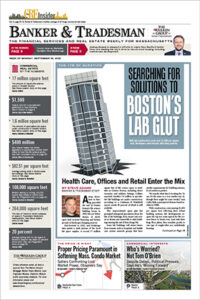Travis D’Amato
Managing director of investment sales, Walker & Dunlop
Age: 43
Industry experience: 22 years
As a long-time commercial real estate broker specializing in multifamily investment sales, Travis D’Amato says these are indeed good times for buyers and sellers of apartment buildings in Greater Boston. The market fundamentals remain strong for investors: steady demand for housing, low supply, solid rent growth and abundant capital. But D’Amato, a managing director at Walker & Dunlap, knows what’s good for investors isn’t necessarily good for multifamily tenants, who are paying top dollar for rents as a result of an acute shortage of all types of housing across the state and region.
Q: Has financing for multifamily housing projects in the Greater Boston area eased up in recent months? If so, how?
A: Yes, particularly for acquisitions and refinancings. The agencies [Fannie Mae and Freddie Mac] have been the most consistent source of capital, and they’re readily lending today. In fact, the vast majority of financing activity we’re seeing, whether it’s new acquisition financing or owners looking to refinance, is flowing through the agencies. While construction debt remains more challenging, it is also available due to the strong local banking market. There’s no question that the broader lending environment has improved from where we were a year ago.
Q: Are banks lending more these days for multifamily projects?
A: Yes, particularly here in New England, where we benefit from a strong and relationship-driven local and regional banking market. Unlike some other parts of the country, many of our regional banks remain active and well-capitalized. They’re selectively lending on multifamily, especially for stabilized or light value-add deals with strong sponsorship. Construction lending is still tight, but if the fundamentals are solid and the sponsor has a track record, we’re seeing regional banks step up and get deals done.
Q: More than 20,000 housing units in Boston alone have been approved but are unable to complete financing. Is that still the case?
A: Very much so. There’s a sizable pipeline of fully entitled, shovel-ready projects across Greater Boston that can’t get off the ground. The economics just don’t pencil right now for many of them. It’s not a rental housing demand issue. It’s a capital stack problem. We’re seeing an uptick in groundbreakings, but overall activity is still well below historic levels.
The projects moving forward today generally fall into two categories. First, you have legacy deals: projects that were entitled and capitalized before rates spiked. These are now breaking ground because they’ve finally worked through permitting or had their capital stack locked.
Second, you’re seeing projects with some form of public support, whether that’s local subsidies, tax incentives, or reduced affordability components that help bridge financing gaps. There are numerous projects breaking ground, particularly along Route 128, [Interstate] 495 and southern New Hampshire.
Q: Are the suburban markets more favorable for construction now than Boston?
A: The key difference today is cost. In the city of Boston, high construction costs make projects much more difficult to deliver. Those costs create a tough capitalization hurdle to overcome, even when the permitting process moves along. In the suburbs, while zoning and local opposition can still be challenging, overall development costs tend to be lower, making projects more financially feasible. So, it’s really the cost structure that sets the city apart from the suburbs right now.
Q: What can the state do to help multifamily construction, beyond existing programs such as Commonwealth Builder for affordable condominiums?
A: They’re trying their best. The governor has an aggressive housing plan. They’re overall trying their best to find ways to get housing built. The MBTA Communities Act was a good idea. But I don’t think they anticipated the opposition of the municipalities. The battle to actually produce a significant amount of housing has been hard. I’m not a politician, but the state is trying. I think the place where they can focus the most is on the ability to get approvals and permits.
Q: What else can the state do besides helping with approvals and permits? Some people say that they can help with infrastructure costs.
A: That’s a good point. When you get out to suburban towns, a lot of these deals require wastewater treatment facilities or wells because they’re far away from public water and sewer. So if the state [could help] build that connection, that could help with the math. The cost would go down and the development becomes more financeable.
Q: How would interest rate cuts affect projects’ financial viability?
A: It would help. But when people talk rate cuts, they’re talking about the Fed rate. That’s not actually what happens in the long-term bond market that people borrow off of. A Fed rate cut is good for morale because people think things are getting better. But when you look at the math, it doesn’t really overall change the cost of debt. You need a lot more than 50 basis points of actual borrowing costs going down to make some of these projects feasible.
Q: Do you see Massachusetts getting out of this current housing logjam anytime soon? The problems we’re facing seem so intractable.
A: There are a couple problems involving the approvals, the math and construction costs. If you look back to the 10 years leading up to the interest rate hike cycle we’ve been in for the last two years, we built about 110,000 units in that 10-year span. That was a much better financing environment. I don’t know how we get to that level over the next 10 years. I don’t see a way out.
D’Amato’s Five Favorite Movies:
- “The Shawshank Redemption”
- “The Usual Suspects”
- “Gladiator”
- “Braveheart”
- “Tommy Boy”





